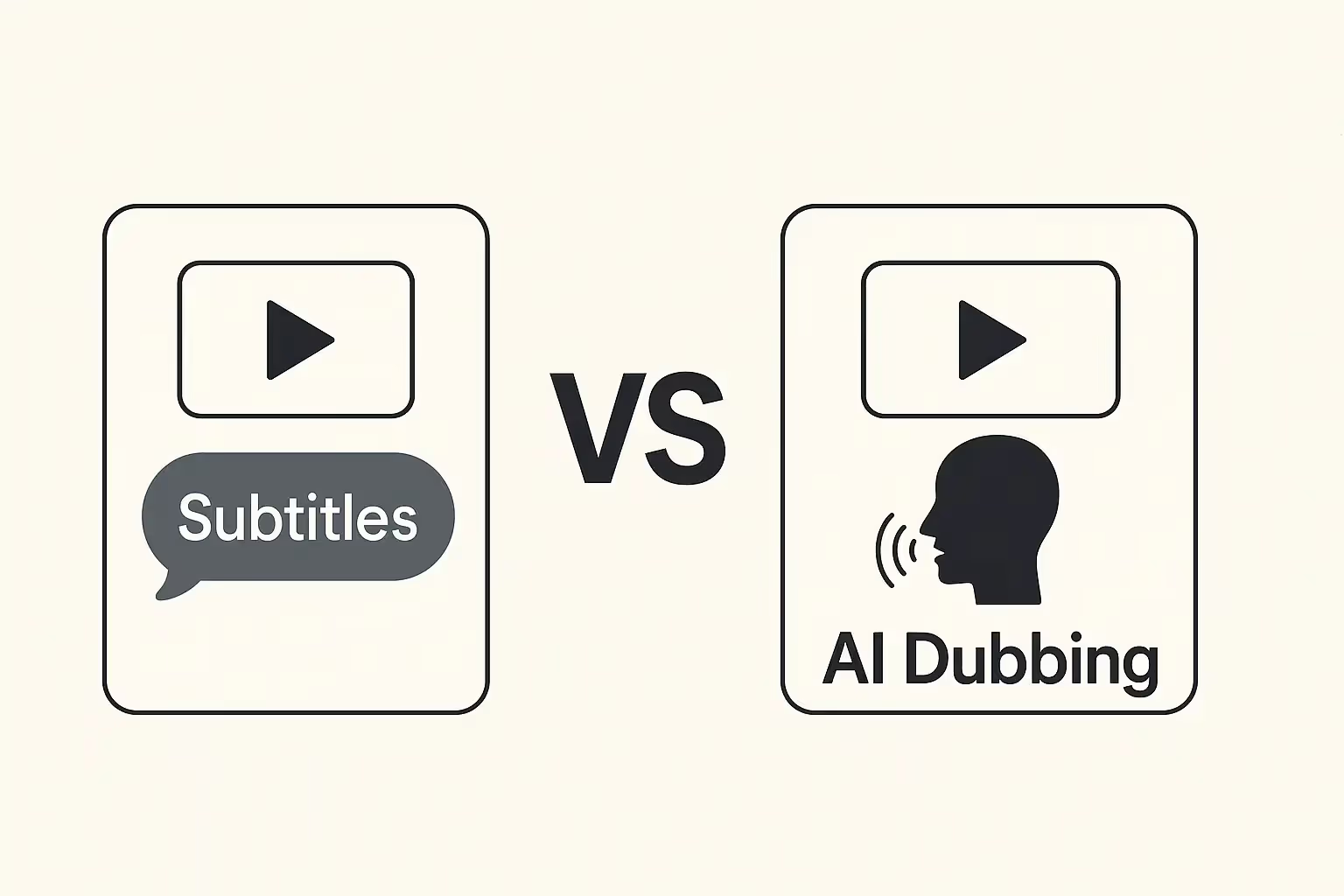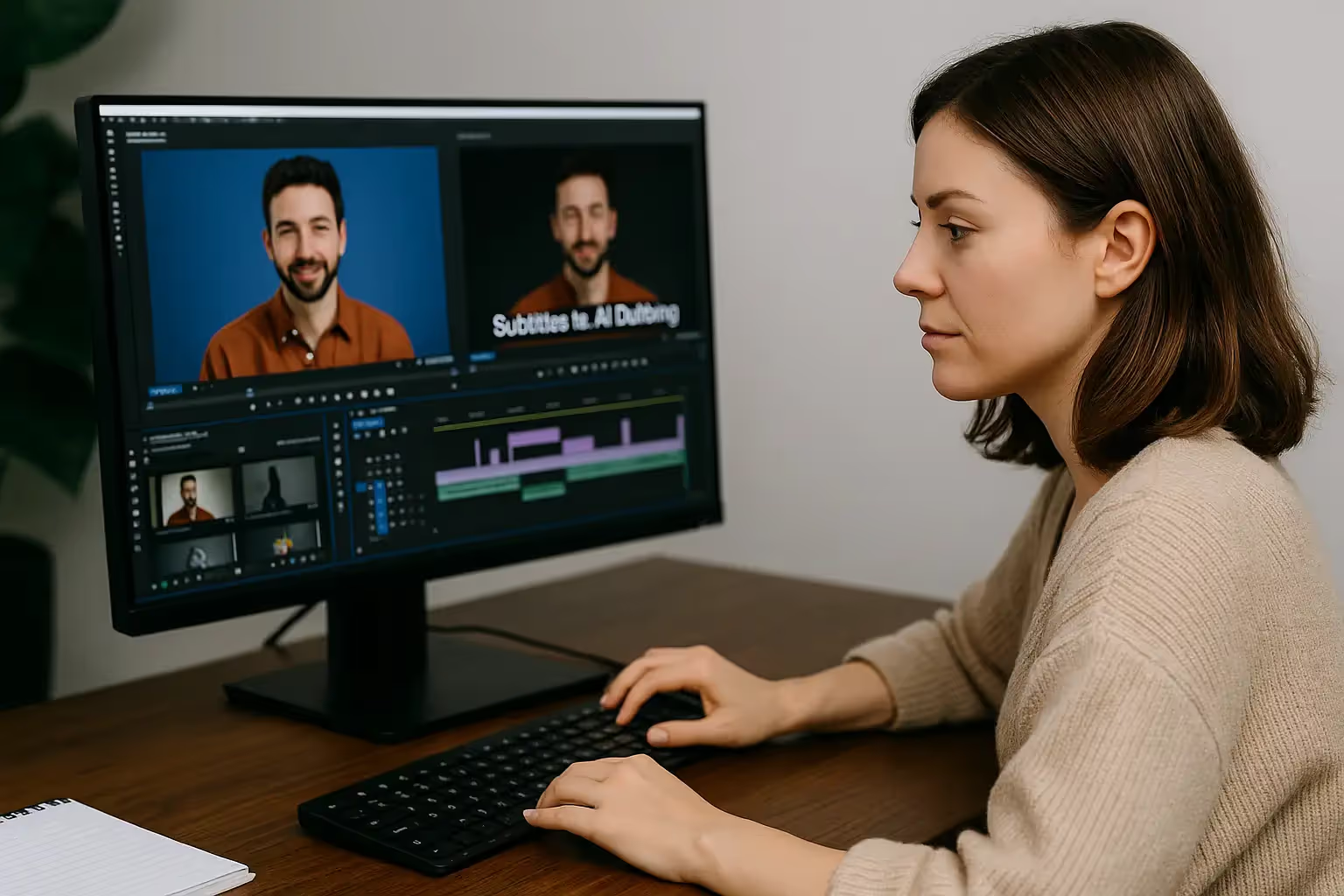Tech
September 12, 2025
Subtitles vs. AI Dubbing: Which Is Better for Your Videos?

What’s the Difference?
Subtitles display translated speech as text on screen. They can be generated automatically or edited manually and are visible while the original audio remains unchanged.
AI Dubbing, on the other hand, replaces the original audio entirely. The tool generates a new voice track in the target language – using realistic-sounding speech, proper timing, and often even lip sync for natural visual flow.
The Pros and Cons
Subtitles are a popular choice because they’re:
- Fast and cost-efficient
- Helpful for silent viewing (e.g. in public transport)
- Great for accessibility and compliance
- Easy to implement with almost any platform
However, subtitles have clear limitations:
- They don’t carry emotion, tone, or vocal character
- Reading while watching can reduce engagement
- On mobile or fast-paced content, subtitles are often missed or ignored
- They don’t work well on platforms like TikTok or Instagram where sound matters
AI Dubbing, in contrast, delivers a much more immersive experience:
- Viewers hear natural speech in their native language
- No reading required – they stay focused on the visuals
- Emotion, tone, and voice dynamics are preserved
- Ideal for marketing, training, storytelling, and high-impact content
- Can include lip sync for maximum realism
The challenges?
- It’s slightly more complex than adding subtitles
- Quality must be reviewed to ensure style and terminology match expectations
- Some edge cases (e.g. overlapping speech, low-quality audio) may need manual tweaks
But with the right tool – like Dubly – these challenges become opportunities. You can edit translations, use glossaries, adjust speed, and even request Native Speaker Control for critical content.

Which Use Cases Fit Each Method?
Subtitles are great for:
- Simple tutorials with little emotion
- Informational videos where audio isn't essential
- Content that must be compliant with accessibility standards
- Dual-language viewing (e.g. for language learners)
AI Dubbing is ideal for:
- Social media content like Reels or TikToks
- Training videos, e-learning courses, onboarding
- Marketing and branding videos where tone matters
- Interviews, podcasts, webinars, and more emotional content
As a rule of thumb:
If how something is said matters as much as what is said – go with dubbing.
FAQ: Subtitles vs AI Dubbing – which is better for your videos
What is the difference between subtitles and AI dubbing?
Subtitles display translated text on screen while keeping the original audio. AI dubbing replaces the audio with a translated voice track, including voice, rhythm, and often lip sync.
When are subtitles more appropriate than dubbing?
Subtitles work well when budget or speed is limited, or for platforms where viewers often watch without sound, such as tutorials or compliance content.
When does AI dubbing make sense?
When emotion, brand voice, or audience engagement matter—like in marketing videos, webinars, or educational content—AI dubbing delivers a more immersive experience.
What are the drawbacks of each method?
Subtitles can distract and fail to convey emotion; AI dubbing requires attention to style, tone, glossaries, and can struggle with poor audio or overlapping speech.
How can subtitles and dubbing be combined effectively?
Using dubbing for impact and engagement, supplemented by subtitles for accessibility and clarity reaches a broader audience in different contexts.
{{cta}}
{{callout}}
Conclusion: Subtitles or AI Dubbing?
Subtitles are practical. AI Dubbing is powerful.
There’s no one-size-fits-all. But for companies, creators, educators, and agencies looking to reach global audiences effectively, AI dubbing is the go-to.
With Dubly, you get the flexibility to adapt – and the tools to do it at scale, with real quality.
Does the Dubly.AI free trial include the Lipsync feature?
Yes. We believe you need to experience the full technology to understand its value. The free trial includes Generative Lipsync and Voice Cloning, not just simple audio translation.
Is there a difference between a standard "Video translater" and Dubly.AI?
Yes. A standard "Video translater" often only translates text or audio. Dubly.AI is a comprehensive AI solution that adapts the visuals (mouth movements) to the audio, creating a seamless experience.
Can I use Dubly.AI for long-form content?
Yes. While many free tools limit you to 60 seconds, Dubly’s engine is built for scale – from TikTok Shorts to hour-long corporate training modules.
Can I use translate video free tools to internationalize my content?
Yes, absolutely. Using free tools is a great starting point to test new markets without a budget. However, keep in mind that methods like subtitles or basic video translator apps usually only transfer information, not emotion. To truly internationalize your brand's personality and retain viewers, you will eventually need lipsync technology to ensure the audience feels connected to you, not just the text.
Does a free ai video translator work for all types of videos?
It works well for content where the speaker is not visible, such as screen recordings or faceless tutorials. However, for any video featuring a person speaking on camera, a standard tool often falls short. Because it lacks lipsync, the visual mismatch distracts the viewer. For content meant to build trust or emotion, you need a solution that adapts both the voice and the visuals.
Is there a free version of Dubly.AI?
You can translate your first video for free so you can validate the quality with your own files. We believe in letting you prove the value first.
Does this work for any language?
Our AI supports over 30 languages, covering the majority of global markets (English, Spanish, German, French, Japanese, Mandarin, etc.). The Lip Sync works universally across these languages.
How accurate is the translation?
AI translation is very good (95%+), but for critical content, context matters. That is why we offer Native Speaker Control (NSC) as an add-on, where humans review the AI's work. This combines the speed of software with the precision of a native speaker.
Can I automate this process?
Yes. For agencies, media houses, or companies with high volume, we offer an API. This allows you to integrate video translation directly into your content management workflow, removing manual upload steps entirely.
Über den Autor

Newest articles

Use Cases
How to Translate Video Free: 3 Ways to multiply your reach
Looking for an AI video translator? We answer how to translate video free using 3 methods: Subtitles, Basic TTS, and Professional Lipsync.

Simon Pieren
December 8, 2025

Use Cases
Translate Video Free: A Guide to AI Translation, Lip Sync & Voice Cloning
Looking to "translate video free"? Learn the technical differences between standard dubbing and generative AI Lip Sync, and how to test professional quality risk-free.

Simon Pieren
November 28, 2025

Use Cases
How AI Video Translation Connects Global Teams
How AI video translation breaks down language barriers in enterprises - secure, empathetic, and scalable.

Simon Pieren
November 24, 2025
